
- •Contents
- •Preface
- •Related Documents
- •Typographic and Syntax Conventions
- •Creating HDL Modules for CDBA Cellviews
- •Creating HDL Data as You Save CDBA Cellviews
- •Creating HDL Data from Pre-existing CDBA Cellviews
- •Quick-Start Tutorial
- •The Circuit
- •AMS Designer Tools
- •Setting Up the Tutorial
- •Running from a Script
- •Running within the AMS Environment
- •Opening the Command Interpreter Window
- •Netlisting and Compiling
- •Elaborating and Simulating the Design
- •Summary
- •Setting Up the AMS Environment
- •Overview
- •The hdl.var File
- •The ams.env Files
- •AMS Designer Supports Design Management
- •Specifying the Text Editor to Use
- •Specifying Fonts for the Cadence Hierarchy Editor
- •Preparing to Use AMS Designer from the Hierarchy Editor
- •Netlisting
- •Netlisting Modes Supported by the AMS Netlister
- •Automatic Netlisting of a Cellview
- •Netlist Updating and Netlisting of Entire Designs
- •Netlisting from the UNIX Command Line
- •Library Netlisting
- •Netlisting of Cells in Response to Changes in CDF
- •Preparing Existing Analog Primitive Libraries for Netlisting
- •Specifying the Behavior of the Netlister and Compilers
- •Opening the AMS Options Windows
- •Setting Netlister Options from the Hierarchy Editor
- •Opening the CIW AMS Options Window
- •Setting Compiler Options
- •Viewing the AMS Netlister Log
- •Understanding the Output from the AMS Netlister
- •How Inherited Connections Are Netlisted
- •Inherited Signal Connections
- •Inherited Terminal Connections
- •Instance Values for Inherited Connections
- •Third-Party Tools and Other Cadence Tools
- •How Aliased Signals Are Netlisted
- •How m-factors (Multiplicity Factors) Are Netlisted
- •How Iterated Instances Are Netlisted
- •Passing Model Names as Parameters
- •Effect of the modelname, model, and modelName Parameters
- •Handling of the model* and componentName Parameters
- •Precedence of the model* and componentName Parameters
- •Specifying Parameters to be Excluded from Netlisting
- •Ignoring Parameters for Entire Libraries
- •Example: Specifying Parameters to Ignore
- •Ensuring that Floating Point Parameters Netlist Correctly
- •Working with Schematic Designs
- •Setting Schematic Rules Checker Options for AMS Designer
- •Creating Cellviews Using the AMS Environment
- •Preparing a Library
- •Creating the Symbol View
- •Using Blocks
- •Descend Edit
- •Inherited Connections
- •Global Signals in the Schematic Editor
- •Inherited Connections in a Hierarchy
- •How Net Expressions Evaluate
- •Net and Pin Properties
- •groundSensitivity and supplySensitivity Properties
- •Making Connect Modules Sensitive to Inherited Connection Values
- •Using External Text Designs
- •Overview of Steps for Using External Text Designs
- •Bringing Modules into a Cadence Library
- •Specifying the Working Library
- •Compiling into Libraries
- •Compiling into Temporary Libraries
- •Listing Compiled Modules
- •Using Text Blocks in Schematics
- •Using Modules Located in a Cadence Library
- •Preparing for Simulation
- •Using Analog Primitives
- •Using SPICE and Spectre Netlists and Subcircuits
- •Preparing to Use SPICE and Spectre Netlists and Subcircuits
- •Placing SPICE and Spectre Netlists and Subcircuits in a Schematic
- •Using Test Fixtures
- •Creating and Using a Textual Test Fixture
- •Creating a Textual Test Fixture
- •Using a Test Fixture
- •Example: Creating and Using a Test Fixture
- •Using Design Configurations
- •Ensuring HDL Design Unit Information Is Current
- •Preparing a Design for Simulation
- •Overview of AMS Design Prep
- •What AMS Design Prep Does to Prepare a Design for Simulation
- •When to Use AMS Design Prep
- •Specifying the Behavior of AMS Design Prep
- •Setting Options for Global Design Data
- •Specifying Global Signals
- •Specifying Design Variables
- •Specifying Model Files to Use During Elaboration
- •Running AMS Design Prep
- •The cds_globals Module
- •Global Signals
- •Design Variables
- •Setting Elaborator Options
- •Setting Simulator Options
- •Setting Waveform Selection Options
- •Creating Probes
- •Selecting Instances from the Virtuoso Schematic Editing Window
- •Selecting Buses
- •Selecting Instances from the Scope Navigator
- •Copying and Pasting Within Tables
- •Elaborating and Simulating
- •Viewing Messages
- •Plotting Waveforms After Simulation Ends
- •Starting the SimVision Waveform Viewer
- •Plotting Waveforms Selected on a Schematic (Direct Plot)
- •Using the amsdesigner Command
- •Examples
- •Producing Customized Netlists
- •Producing Customized Netlists
- •Identifying the Sections of a Netlist
- •Using ams.env Variables to Customize Netlists
- •Using Netlisting Procedures to Customize Netlists
- •Examples: Problems Addressed by Customized Netlists
- •Example: Adjusting Parameter Values to Account for Number of Fingers
- •Example: Using Symbols that Represent Verilog Test Code
- •Data Objects Supported for Netlisting
- •Netlister Object
- •Formatter Object
- •Cellview Object
- •Parameter Object
- •Instance Object
- •SKILL Functions Supported for Netlisting
- •Default Netlisting Procedures
- •Netlisting Helper Functions
- •Variables for ams.env Files
- •How AMS Designer Determines the Set of Variables
- •Why AMS Designer Uses ams.env Files, Not .cdsenv Files
- •List of ams.env Variables
- •Detailed Descriptions of ams.env Variables
- •aliasInstFormat
- •allowDeviantBuses
- •allowNameCollisions
- •allowSparseBuses
- •allowUndefParams
- •amsCompMode
- •amsDefinitionViews
- •amsEligibleViewTypes
- •amsExcludeParams
- •amsExpScalingFactor
- •amsLSB_MSB
- •amsMaxErrors
- •amsScalarInstances
- •amsVerbose
- •analogControlFile
- •bindCdsAliasLib
- •bindCdsAliasView
- •cdsGlobalsLib
- •cdsGlobalsView
- •checkAndNetlist
- •checkOnly
- •checktasks
- •compileAsAMS
- •compileExcludeLibs
- •compileMode
- •connectRulesCell
- •connectRulesCell2
- •connectRulesLib
- •connectRulesView
- •detailedDisciplineRes
- •discipline
- •excludeViewNames
- •hdlVarFile
- •headerText
- •ieee1364
- •ifdefLanguageExtensions
- •incdir
- •includeFiles
- •includeInstCdfParams
- •initFile
- •instClashFormat
- •iterInstExpFormat
- •language
- •lexpragma
- •logFileAction
- •logFileName
- •macro
- •maxErrors
- •messages
- •modifyParamScope
- •ncelabAccess
- •ncelabAnnoSimtime
- •ncelabArguments
- •ncelabCoverage
- •ncelabDelayMode
- •ncelabDelayType through ncelabMessages
- •ncelabMixEsc
- •ncelabModelFilePaths
- •ncelabNeverwarn through ncelabVipdelay
- •ncsimArguments
- •ncsimEpulseNoMsg through ncsimExtassertmsg
- •ncsimGUI
- •ncsimLoadvpi through ncsimStatus
- •ncsimTcl
- •ncsimUnbuffered through ncsimUseAddArgs
- •ncvhdlArguments
- •ncvlogArguments
- •ncvlogUseAddArgs
- •netClashFormat
- •netlistAfterCdfChange
- •netlistMode
- •netlistUDFAsMacro
- •neverwarn
- •noline
- •nomempack
- •nopragmawarn
- •nostdout
- •nowarn
- •paramDefVals
- •paramGlobalDefVal
- •pragma
- •processViewNames
- •prohibitCompile
- •runNcelab
- •runNcsim
- •scaddlglblopts
- •scaddltranopts
- •scale
- •scalem
- •scannotate
- •scapprox
- •scaudit
- •sccheckstmt
- •sccmin
- •sccompatible
- •scdebug
- •scdiagnose
- •scdigits
- •scerror
- •scerrpreset
- •scfastbreak
- •scgmin
- •scgmincheck
- •schomotopy
- •sciabstol
- •scic
- •scicstmt
- •scignshorts
- •scinfo
- •scinventory
- •sclimit
- •sclteratio
- •scmacromod
- •scmaxiters
- •scmaxnotes
- •scmaxrsd
- •scmaxstep
- •scmaxwarn
- •scmethod
- •scmodelevaltype
- •scmosvres
- •scnarrate
- •scnotation
- •scnote
- •scopptcheck
- •scpivabs
- •scpivotdc
- •scpivrel
- •scquantities
- •screadic
- •screadns
- •screlref
- •screltol
- •scrforce
- •scscale
- •scscalem
- •scscftimestamp
- •scscfusefileflag
- •scskipcount
- •scskipdc
- •scskipstart
- •scskipstop
- •scspeed
- •scstats
- •scstep
- •scstop
- •scstrobedelay
- •scstrobeperiod
- •sctemp
- •sctempeffects
- •sctitle
- •sctnom
- •sctopcheck
- •sctransave
- •scusemodeleval
- •scvabstol
- •scwarn
- •scwrite
- •simRunDirLoc
- •simVisScriptFile
- •status
- •templateFile
- •templateScript
- •timescale
- •update
- •use5xForVHDL
- •useDefparam
- •useNcelabNowarn
- •useNcelabSdfCmdFile
- •useNcsimNowarn
- •useNowarn
- •useScaddlglblopts
- •useScaddltranopts
- •useScic
- •useScreadic
- •useScreadns
- •useScwrite
- •useSimVisScriptFile
- •useProcessViewNamesOnly
- •verboseUpdate
- •vlogGroundSigs
- •vloglinedebug
- •vlogSupply0Sigs
- •vlogSupply1Sigs
- •wfDefaultDatabase
- •wfDefInstCSaveAll
- •wfDefInstCSaveLvl
- •wfDefInstSaveCurrents
- •wfDefInstSaveVoltages
- •wfDefInstVSaveAll
- •wfDefInstVSaveLvl
- •wfDefInstVSaveObjects
- •Updating Legacy SimInfo for Analog Primitives
- •The ams Fields
- •Special Handling of model, modelName, modelname, and componentName
- •Converting an Existing Analog Primitive Library
- •Designing for Virtuoso AMS Compliance
- •Terminals
- •Buses
- •Component Description Format
- •Parameters
- •Using Inherited Parameters
- •Using Cell Parameters
- •Parameterized Cells
- •VHDL-AMS Component Declarations
- •Properties
- •Properties to Avoid Completely
- •Avoid the portOrder Property Unless Required by Special Circumstances
- •Properties to Use Only in AMS Compatibility Mode
- •Properties That Have No Special Meaning in the AMS Environment
- •Properties Fully Supported by the AMS Environment
- •SKILL Functions
- •amsCheckCV
- •amsIsPresent
- •amsNetlist
- •amsProcessCellViews
- •amsUIOptionsForm
- •amsUIRunNetlisterForm
- •ddsCvtAMSTranslateCell
- •ddsCvtAMSTranslateLib
- •ddsCvtToolBoxAMS
- •vmsUpdateCellViews
- •Customization Variables
- •schHdlNotCreateDB
- •schHdlUseVamsForVerilog
- •vmsAnalysisType
- •vmsCreateMissingMasters
- •vmsNcvlogExecutable
- •vmsPortProcessing
- •vmsRunningInUI
- •vmsTemplateScript
- •vmsVerboseMsgLevel
- •Compiling Cadence-Provided Libraries
- •Purpose of the amsLibCompile Tool
- •Running the amsLibCompile Tool Manually
- •Example

Virtuoso AMS Environment User Guide
Producing Customized Netlists
Example: Using Symbols that Represent Verilog Test Code
The goal in this example is to place a symbol representing a piece of Verilog test code in a schematic, and to have the test code inserted into the netlist. The symbol, which has no pins, is just a vehicle for the test code.
There are several steps involved in setting up for this approach.
1.Prepare a cellview that contains the test code. For this example, assume that the full name of the cellview is NetlistLib.verinc:verilog_include and that the following test code is in a file calledverilog.v in that cellview.
//--- begin included file ---
//Design debugger/monitor
parameter TCOff=0;
‘ifdef CHECK_INPUT_TRANSITIONS
always @(posedge(TCOff||in_d) or negedge(TCOff||in_d)) if (eval==1’b1)
$display($stime," WARNING: %m in_d transition (evaluate is active)");
always @(posedge(TCOff||out_y) or negedge(TCOff||out_y)) if (eval==1’b1)
$display($stime," INFO: %m out_y transition (evaluate is active)");
‘endif
// ---- end of included file ----
Ultimately, this code is written into the netlist so that if the CHECK_INPUT_TRANSITION variable is set, the code checks the transitions.
April 2004 |
318 |
Product Version 5.3 |
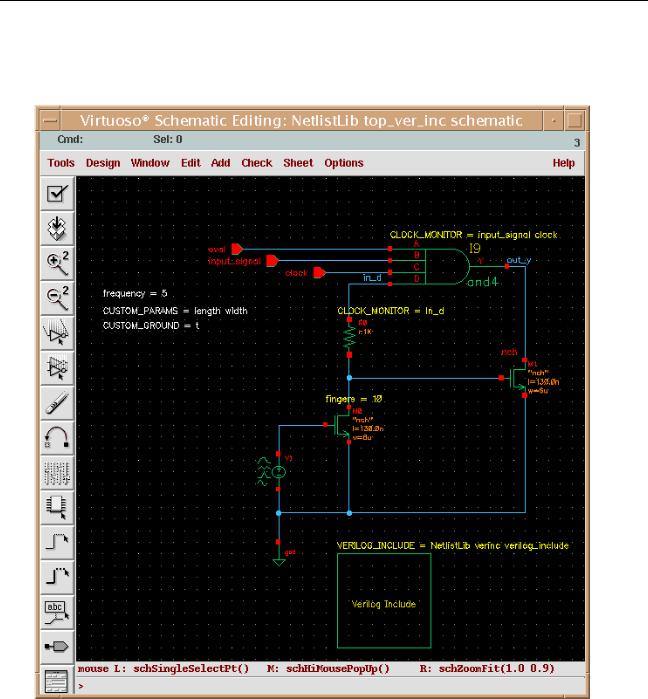
Virtuoso AMS Environment User Guide
Producing Customized Netlists
2.Create a symbol and place it in the schematic whose netlist is to contain the test code.
In the following schematic, for example, notice the simple square symbol labeled
Verilog Include.
3.Select the placed symbol and open the Edit Object Properties form for it. Add a User
Property called VERILOG_INCLUDE with a value that indicates the full name of the cellview that contains the test code. In Step 1, the code was placed in the cellview
NetlistLib.verinc:verilog_include, so in this step enter the corresponding
April 2004 |
319 |
Product Version 5.3 |
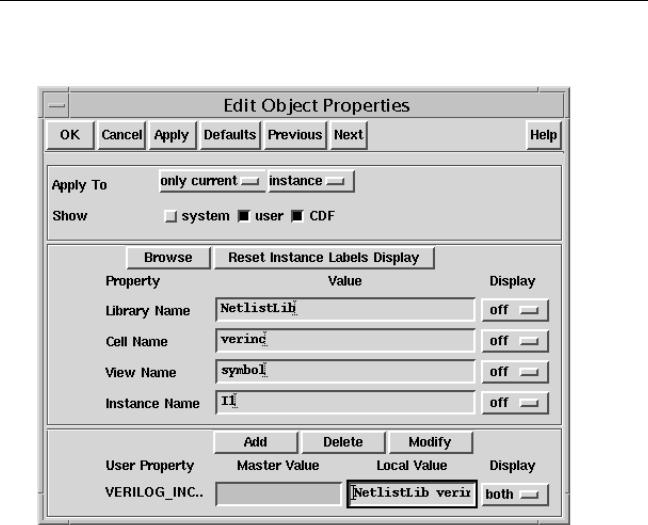
Virtuoso AMS Environment User Guide
Producing Customized Netlists
value NetlistLib verinc verilog_include, leaving out the punctuation. Apply the changes. After these steps, the form looks like this.
4.Create the override file. The override file is associated with only theverinc cell, so the appropriate override file to use is alibInit.il in the NetlistLib library.
;;=======================================================================
;;A custom netlist procedure for macro substitution.
;;=======================================================================
(defun myInstanceVerilogInclude (formatter cellview inst)
(let (lcv file)
;; Check for property VERILOG_INCLUDE on the instance
;;
(when inst->id->VERILOG_INCLUDE
(setq lcv (parseString inst->id->VERILOG_INCLUDE)) ;; Get the the default file name verilog.v
(setq file (ddGetObj (car lcv) (cadr lcv) (caddr lcv) "verilog.v"))
;; Read in the file and print the contents (if (null file)
(progn
sprintf(errmsg "Expected a verilog.v in %s:%s.%s\n" (car lcv) (cadr lcv) (caddr lcv) )
April 2004 |
320 |
Product Version 5.3 |
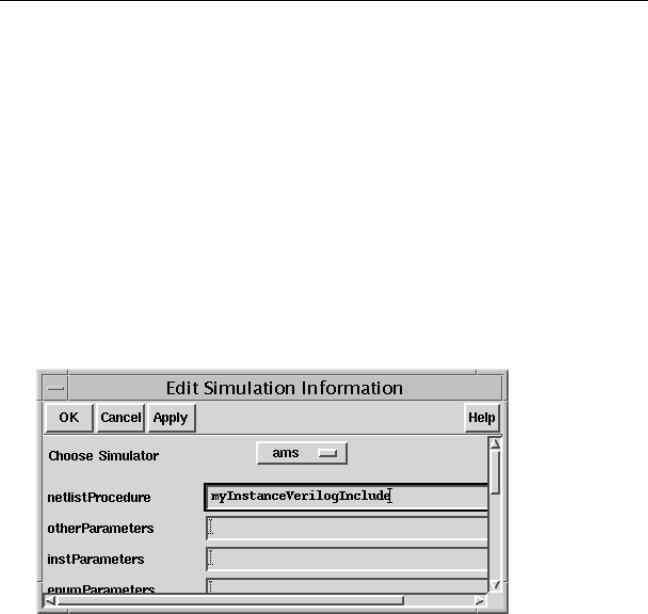
Virtuoso AMS Environment User Guide
Producing Customized Netlists
(amsError formatter errmsg)
)
(prog (filePort lineBuffer)
;; Open the file, and start printing contents of the file (setq filePort (infile file->readPath))
(while (gets lineBuffer filePort) (amsPrint formatter lineBuffer)
) ; while
(close filePort) ) ; prog
) ; if
) ; when
) ; let
) ; defun
5.Open the Edit Component CDF form for the netlistLib.verinc cell, then from that form open the Edit Simulation Information form. Choose the ams simulator and add the name of the overriding netlisting procedure in the netlistProcedure field. After these steps, the form looks like this:
6.Click OK, in the Edit Component CDF form.
7.Netlist the schematic.
The generated netlist includes the checking code that you specified inStep 1. An excerpt from the netlist looks like this:
nmos #(.ps(1.268u), .as(2.04E-12), .l(130.0n), .pd(12.68u), .ad(2.04E-12),
.w(6u), .m(2))
(* integer library_binding = "analogLib"; integer passed_mfactor = "m"; *)
M1 ( out_y, net20, cds_globals.„nd! , •ulk_n_gnd! );
nmos #(.ps(11.6u/10), .as(1.32E-12/10), .l(130.0n), .pd(9.8u/10), .ad(1.14E- 12/10),
.w(6u/10), .m(2*10))
April 2004 |
321 |
Product Version 5.3 |

Virtuoso AMS Environment User Guide
Producing Customized Netlists
(* integer library_binding = "analogLib"; integer passed_mfactor = "m"; *)
M0 ( net20, net9, cds_globals.„nd! , •ulk_n_gnd! );
//--- begin included file ---
//Design debugger/monitor
parameter TCOff=0;
‘ifdef CHECK_INPUT_TRANSITIONS
always @(posedge(TCOff||in_d) or negedge(TCOff||in_d))
if (eval==1’b1)
$display($stime," WARNING: %m in_d transition (evaluate is active)"); always @(posedge(TCOff||out_y) or negedge(TCOff||out_y))
if (eval==1’b1)
$display($stime," INFO: %m out_y transition (evaluate is active)");
‘endif
// ---- end of included file ----
Example: Using CDF Instance Parameters to Define Inherited Connections
This example illustrates how to establish inherited connections on programmable nodes in such a way that the names and values of the inherited connections are calculated from object properties and can vary for each instance. This allows each of the instances within a single schematic to have different inherited connections.
For example, assume that you have an instance, M1, and that the Substrate connection
field of the Edit Object Properties form for that instance contains the valuesub!. That value needs to result in an inherited connection definition, like this.
wire
(* integer inh_conn_prop_name="\\sub! ";
integer inh_conn_def_value="cds_globals.\\sub! "; *) \sub!_sub! ;
The inherited connection is to be used to instantiate the instance, like this.
ns3v025d #(.as(4.64E-12), .ps(1.664E-05), .m(3), .ad(4.64E-12),
.pd(1.664E-05),.l(3.2E-07), .w(1E-05)) (* integer library_binding = "cmos025";
integer passed_mfactor = "m"; *)
M1 ( D1, G, S, Bulk, Dnw, \sub!_sub! );
These results can be achieved by using a netlisting function to build, from the instance information contained in the Edit Object Properties form, an appropriate list for the extraTerminals field of the Edit Simulation Information form. The netlister then recalculates and uses that list to construct the necessary instantiation statements for each programmable node of each instance.
To implement this technique, use the following steps.
1. Determine what object properties are to be used as input to the netlisting function.
April 2004 |
322 |
Product Version 5.3 |

Virtuoso AMS Environment User Guide
Producing Customized Netlists
The component being netlisted for this example is a mosfet, which has three programmable nodes. By examining the Edit Component CDF form for the cell, you find that the programmable nodes are: bulkNode, sub_node, and dnw_node. These are the names you use in the netlisting function, as described in the next step.
2.Prepare the netlisting function. The function must generate lists that are appropriate for the extraTerminals field of the cell CDF, using as input the object property values associated with each instance. If no object property values are specified, the function needs to create default output.
The following function is one example that meets these requirements.
(defun AMSnmos_dnw_inhExtraTerminals (inst "g")
(let
;; Default values
( (term1 ’(nil name "B" direction "inputOutput" netExpr)) (netExpr1 "[@vbulk_n:%:vssa!]")
(term2 ’(nil name "DNW" direction "inputOutput" netExpr)) (netExpr2 "[@vdnw:%:not_set!]")
(term3 ’(nil name "SUB" direction "inputOutput" netExpr)) (netExpr3 "[@vsub:%:not_set!]")
)
;;Override values, if any. (if (inst != nil) then
(if (inst->bulkNode != "") then
netExpr1 = (strcat "[@" inst->bulkNode ":%:" inst->bulkNode "]")
)
(if (inst->dnw_node != "") then
netExpr2 = (strcat "[@" inst->dnw_node ":%:" inst->dnw_node "]")
)
(if (inst->sub_node != "") then
netExpr3 = (strcat "[@" inst->sub_node ":%:" inst->sub_node "]")
)
)
;;Generate the dynamic "extraTerminals" list.
extraTerminals = (list (append1 term1 netExpr1) (append1 term2 netExpr2)
(append1 term3 netExpr3) )
);let
);defun
For example, the function generates the following default value for B.
(nil name "B" direction "inputOutput" netExpr "[@vbulk_n:%:vssa!]")
Referring to “extraTerminals” on page 590, you see that this value instructs the AMS netlister to create a connection for a terminal B in the instance connection port list for all instances of the mosfet device. The terminal is to be an input/output terminal. The netlist expression indicates that a property called vbulk_n is to be consulted for the name of the net to which terminal B is to be connected. In addition, if vbulk_n is not found, the vssa! net is to be used.
April 2004 |
323 |
Product Version 5.3 |
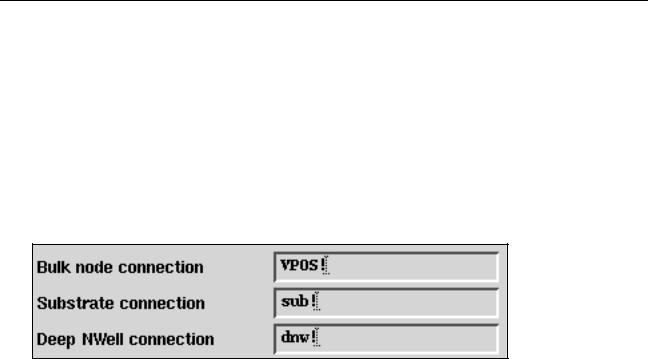
Virtuoso AMS Environment User Guide
Producing Customized Netlists
The most interesting part of this function, however, is the Override values section.
In that section, the if statements of the form
(if (inst->bulkNode != "") then |
|
netExpr1 = (strcat "[@" inst->bulkNode ":%:" inst->bulkNode "]") |
) |
check for a value entered in a field of the Edit Object Properties form and generate a netExpr based on that value. In this function, inst->bulkNode refers to the value entered in the Bulk node connection field. Thednw_node and sub_node terms refer to the Substrate connection and Deep NWell connection fields. Assuming that values like the following have been entered into the fields of the Edit Object Properties form for a particular instance,
the function generates an extraTerminals list like this.
((nil name "B" direction "inputOutput" netExpr "[@VPOS!:%:VPOS!]") (nil name "DNW" direction "inputOutput" netExpr "[@dnw!:%:dnw!]") (nil name "SUB" direction "inputOutput" netExpr "[@sub!:%:sub!]"))
The netlister then uses the extraTerminals list to generate inherited connections in the netlist.
3.Place the function in an override file. The function described in this example is associated with only the mosfet cell, so the appropriate override file to use is alibInit.il in the library that contains the cell.
4.Enter the name of the function in the extraTerminals field of the cell CDF.
a.From the CIW, choose Tools – CDF – Edit.
The Edit Component CDF form appears.
b.Specify the instance master in the Library Name and Cell Name fields.
The form expands to display the information for that master.
c.Ensure that CDF Type is set to Base.
d.Scroll down to the Simulation Information section and click Edit.
The Edit Simulation Information form appears.
e.Ensure that ams appears in the Choose Simulator field.
April 2004 |
324 |
Product Version 5.3 |
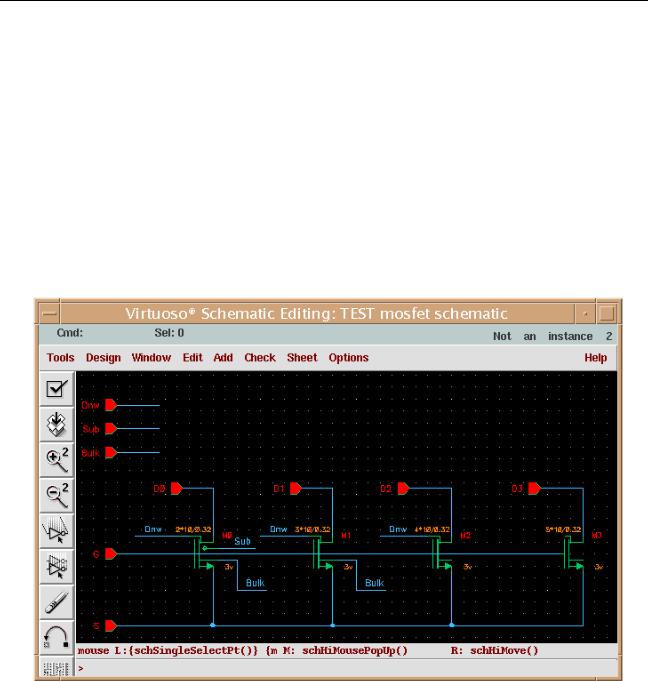
Virtuoso AMS Environment User Guide
Producing Customized Netlists
f.Scroll down to the extraTerminals field and enter the name of the function, using the following format.
FUNCTION AMSnmos_dnw_inhExtraTerminals
g.Click OK in the Edit Simulation Information form.
h.Click OK in the Edit Component CDF form.
Now whenever the netlister consults the extraTerminals field, the value of the field is calculated by the function.
5.Open the schematic that contains the instances that you want to connect with inherited connections.
For example, a schematic containing four instances of a mosfet might look like this.
6.Highlight an instance for which you want to create an instance-specific inherited connection and choose Edit – Properties – Objects from the menu of the schematic editing window.
The Edit Object Properties form appears.
7.Set the values of the programmable nodes for this instance.
April 2004 |
325 |
Product Version 5.3 |

Virtuoso AMS Environment User Guide
Producing Customized Netlists
The programmable nodes for the mosfet symbol appear as the Bulk node connection,
Substrate connection, and Deep NWell connection fields. The illustration inStep 2 shows some possible values. The fields can also be left blank if you want the default net expression for that programmable node of the instance. (The default net expression is defined in the function, as described inStep 2.)
8.Netlist the schematic that contains the instances of interest.
Notice how the inherited connections for the instances are affected by the values you enter in Step 7. For example, if the programmable node fields are left blank for instance
M0 and if the fields are set with the valuesVPOS!, sub!, and dnw! for instance M3, the resulting (partial) netlist looks like this.
module mosfet ( G,Bulk,D3,S,D1,Sub,Dnw,D0,D2 );
input G; input Bulk; input D3; input S; input D1; input Sub; input Dnw; input D0; input D2;
wire
(* integer inh_conn_prop_name="\\sub! ";
integer inh_conn_def_value="cds_globals.\\sub! "; *) \sub!_sub! ;
wire
(* integer inh_conn_prop_name="\\dnw! ";
integer inh_conn_def_value="cds_globals.\\dnw! "; *) †nw!_dnw! ;
wire
(* integer inh_conn_prop_name="\\VPOS! ";
integer inh_conn_def_value="cds_globals.\\VPOS! "; *) \VPOS!_VPOS! ;
wire
(* integer inh_conn_prop_name="\\bulk! ";
integer inh_conn_def_value="cds_globals.\\bulk! "; *) •ulk!_bulk! ;
ns3v025d #(.as(4.64E-12), .ps(1.664E-05), .m(5), .ad(4.64E-12), .pd(1.664E- 05),
.l(3.2E-07), .w(1E-05))
(* integer library_binding = "cmos025"; integer passed_mfactor = "m"; *)
M3 ( D3, G, S, \VPOS!_VPOS! , \dnw!_dnw! , \sub!_sub! );
ns3v025d #(.as(4.64E-12), .ps(1.664E-05), .m(2), .ad(4.64E-12), .l(3.2E-07),
.pd(1.664E-05), .w(1E-05))
(* integer library_binding = "cmos025"; integer passed_mfactor = "m"; *)
M0 ( D0, G, S, Bulk, Dnw, Sub );
...
endmodule
April 2004 |
326 |
Product Version 5.3 |
